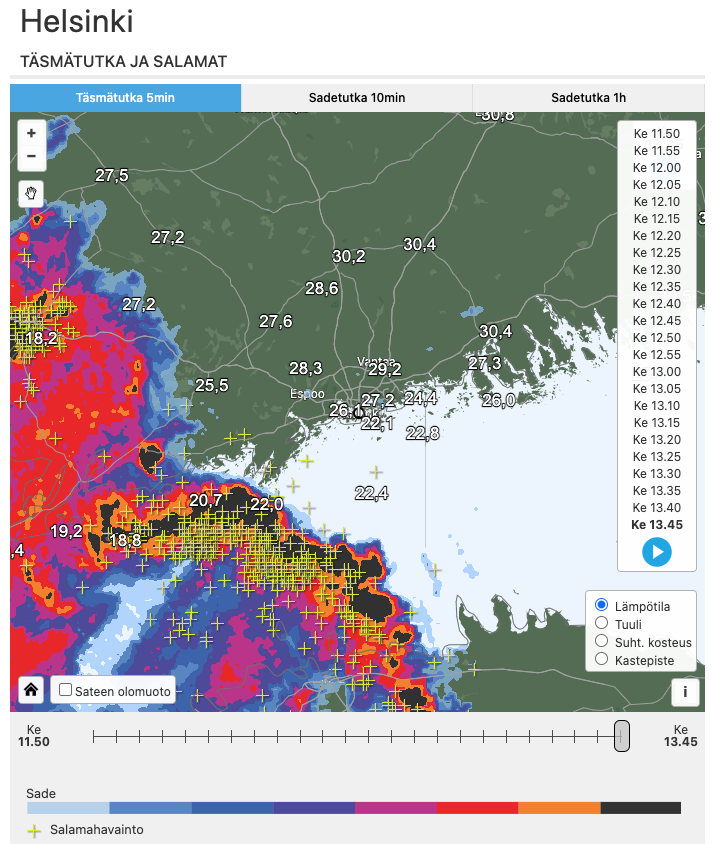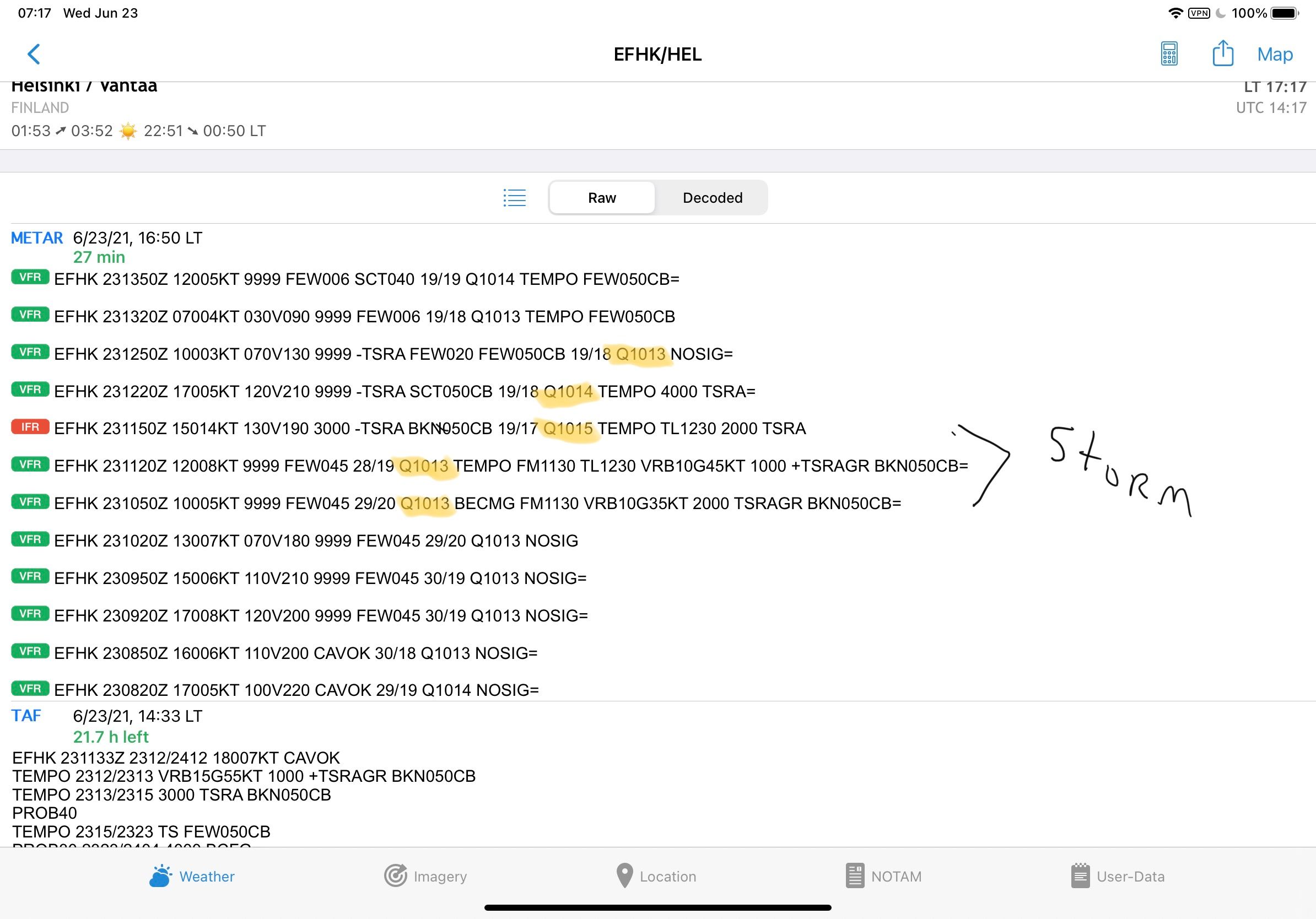Automatic alti/baro really needs attention
-
You could imagine that when you are working remotely from your home (i.e. you are not moving) you could get storm alert when this hits:

But no, just the altitude changes quickly…
Most frustrating thing during the last covid-year of working remotely, is having to adjust the altitude constantly - even after runs or walks where the GPS has been active.
-
@hgavert the component cannot really guess if it’s storm or altitude changes. If the change is so rapid to create altitude changes that means that if the formula is inversed as you suggest it would register storm alarms for an elevator or stairs changes
-
@dimitrios-kanellopoulos
So, it’s not at all using the motion & acceleration sensors to recognise that I’m not actually walking? It does use them to get the steps for example. Elevators are much faster still… -
Also, it could check the location from the app, when it’s syncing with the app. App could tell that yes, this guy is still sitting at home and the altitude is still probably exactly the same as it has been for the last year in this location.
-
@Dimitrios-Kanellopoulos I’d also be happy with the setting “change only the baro / keep altitude fixed” - but no such setting. Yet, this really needs attention. I’m pretty sure one can recognise from the data when a person is walking or running, or sitting or in an elevator. I mean, my Oura tells me to stretch my legs from time to time, when sitting down. It’s also in my hand that moves the same amount. Actually more, as it’s fingers move more than the wrist.
-
@hgavert I think if the watches doesn’t move, the altitude doesn’t change. Only the pressure.
-
@hgavert from manual “If you are at a constant altitude (less than 5 meters of vertical movement within 12 minutes), your watch interprets air pressure changes as weather changes and adjusts the barometer graph accordingly.”
-
@pavlas the reality to make this happen is a little more complex than the manual suggests.
the pressure sensor is delivering data of the absolute pressure.
To differenciate between altitude and pressure change the gradient will be evaluated. How quickly does the prssure change. If it changes quickly, the change is regarded as altitude change.
If it changes slowly, it is regarded as pressure change. If the pressure change is big enough (but below the threshold), it triggers a storm alarm.Now those thresholds are fixed, there might be rare storm occasions that have such a quick pressure change to not trigger the storm alarm and make the watch switch to altitude measurement.
The idea of taking additional information (like from the acceleration sensor) is cool. In reality, it would only work if you sit rather still. If you walk around the house, it would fil again. Also position information from the app would only work in rare conditions.
So while there might be room for improvement, it is immportant to understand the underlying algorithm which has its limitations
-
I’m assuming the screenshot that you posted is from the weather earlier today that moved through Helsinki. Even though it was a strong thunderstorm with gusty winds there doesn’t appear to be a significant pressure change with it.
The Suunto storm alarm requires a 4hPa (1hPA = 1mb) drop in pressure over 3 hours to trigger the alarm.
Here is a screenshot with the pressure highlighted from the airport in Helsinki EFHK. In todays case there was never a change of more than 2mb.

-
My Suunto 9 changed the altitude from 30m to somewhere in 65-70m range during the time a human noticed that a huge storm is hitting (about maybe 30 min).
-
@egika said in Automatic alti/baro really needs attention:
@pavlas the reality to make this happen is a little more complex than the manual suggests.
the pressure sensor is delivering data of the absolute pressure.
To differenciate between altitude and pressure change the gradient will be evaluated. How quickly does the prssure change. If it changes quickly, the change is regarded as altitude change.
If it changes slowly, it is regarded as pressure change. If the pressure change is big enough (but below the threshold), it triggers a storm alarm.Now those thresholds are fixed, there might be rare storm occasions that have such a quick pressure change to not trigger the storm alarm and make the watch switch to altitude measurement.
The idea of taking additional information (like from the acceleration sensor) is cool. In reality, it would only work if you sit rather still. If you walk around the house, it would fil again. Also position information from the app would only work in rare conditions.
So while there might be room for improvement, it is immportant to understand the underlying algorithm which has its limitations
The problem is in detecting the non movement. Like I said in the beginning, I’ve been sitting in meetings during the whole day at home. Actually, it’s been very clear for the whole covid-year that this algorithm is not working.
You said it would be great to understand the limitations - that’s why I’d love to have the old setting, where everything is regarded as change in barometric pressure unless you are in sports model. Btw, I’ve noticed that the sport modes that use the hybrid with GPS, also do not seem to “fix” the altitude. The watch is tracking you well around your jog but the home altitude is still wrong.
So, maybe I’ll paraphrase you: it would be great if Suunto would understand the limitations of the current algorithm and either make it better or give back the option to have it fixed for only baro.

And all in all, that was a storm that you really would have needed to get the storm alert for

-
Why Suunto doesn’t offer the choose to lock barometer in “altimeter mode” or “barometer mode” like Garmin does?
-
@renton82 maybe because users will forget about that, and then complain that “my watch does not record altitude, duck you Suunto”

-
interesting post… I received a storm alert when I came back home after a nice MTB tour while sitting in the sun on the balcony… no bad weather came in, just few clouds.
yesterday evening I did not receive any alert and my entire neighbourhood looks aweful… cars in golfball shape without windows, cracked windshields, roof tiles broken or completely gone, completely cracked roof windows etc.
this would confirm the slow vs fast changing pressure setup -
@freeheeler Basically, if you see it coming you won’t get an alarm

-
i guess for now we need to rely on knee pain

-
Interesting post, particularly the reference to storms not coming with significant pressure changes. My experiences in last weeks with my S9B is that the storm alarm is not working really well. We had several storm episodes in the area lately (a couple of days with really big storms and rapid and big weather changes) and in none of them the alarm triggered with different scenarios (the watch standing by me on my desk, on my wrist, walking or in a car). I wondered a lot why, but the fact is that the alarm never started in any of those cases (at least, five different episodes)
-
@efejota Just to be sure… you did turn storm alarm on in the settings?
If so, the watch should trigger an alarm if the pressure drops with a rate of 3-4 hpa per hour. -
@surfboomerang yes, I checked it to be sure.
-
@efejota Hello, and five days ago (Saturday) I had a terrible storm, with lightning, a hurricane that knocked down many large trees and caused great damage to many places across the country, in some places there were floods with destroyed crops, broken walls of houses, removed fences of yards, etc. The same day (before the storm started) my girl and I were high in the mountains (2500 m), planning to spend the night at this height in a tent! Although, my storm alarm is always on, I checked just in case because the weather forecast was for light rain! Until late afternoon we were hesitant to stay at 2500 meters for the night, relying on my Suunto 9 Baro Titanium that if something scary is asked it will inform me (as my Ambit 2 Sapphire used to do)! But my S9B does not react in any way! We stood on the roof of the mountain and watched in the distance as the black storm clouds set in, and my S9B seemed to have swallowed its tongue. I was wondering who to trust - my eyes or S9B. In the end, reason prevailed and we quickly moved out of the mountain as the storm hit us hard! When we were already traveling by car, the storm was in full swing. We crossed the whole country, as the storm was moving with us, it was scary, trees were falling on the road we were traveling on … The next day we saw the whole balance of the past storm on the news … I don’t think if I had trusted the alarm of my S9B and we were left at 2500 m in a tent, imagine what was there!